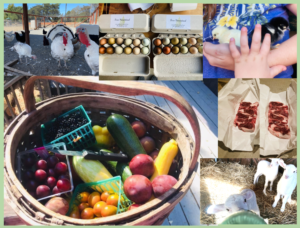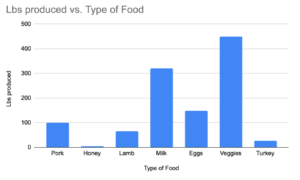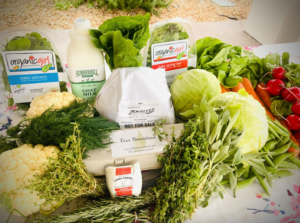
You’ve probably heard of a “CSA Share” (Community Supported Agriculture) and maybe even a herd share or meat share. The word “share” in this context is the system by which farmers sell their products directly to the public by making the customers part owners of the garden, flock, or herd. This system is often used by people who want to bypass regulations (like the prohibition against selling raw milk) or frameworks (like the capitalist perpetuation of wealth inequality).
At Fern Homestead, we see no need to:
- Put you in a position to needlessly pay a distributor to provide food you could receive directly
- Put ourselves in a position that we must accept whatever price is offered to us
- Burden the environment with unnecessary miles traveled and disposable packaging
Our projected farm products for 2024 include: garden fruits and veggies, culinary herbs, eggs, turkey, lamb, honey, goat milk, cheese, and pork. It’s estimated to provide approximately 60% of your diet (according to a mediterranean diet model) for about 10 months per year. And I’ll bet it’s 60% of your most expensive grocery purchases. What don’t we provide? Whole grains or oil. Our small farm isn’t suitable for grain or oil production, and other people are already doing it better than we could anyway.
Fern Homestead yield projections 2024:
 If you’re spending about 13% of your food budget on whole grains and oils like the USDA estimates, that will cost you about $1,300 per year, in addition to our farm share fees. Because you’re definitely eating a 100% healthy diet with no processed foods like all the rest of us, right? You could theoretically be eating a healthy, balanced diet, with limited processed foods, for ten months out of the year for an estimated cost of $4,000. That’s $400 per month, per family. Let’s say $100 per month, per person.I offer a simple experiment. Next month at the grocery store, save your receipts. Are you spending more than $100 per month, per person? I’m guessing a lot more. Let’s take off those yummy extras like processed sugar and flour and just get fresh bread, whole grains, and bulk olive oil, along with fresh veggies, milk, eggs, and meat. It’s still going to be quite a bit more than $100. Just my hypothesis.
If you’re spending about 13% of your food budget on whole grains and oils like the USDA estimates, that will cost you about $1,300 per year, in addition to our farm share fees. Because you’re definitely eating a 100% healthy diet with no processed foods like all the rest of us, right? You could theoretically be eating a healthy, balanced diet, with limited processed foods, for ten months out of the year for an estimated cost of $4,000. That’s $400 per month, per family. Let’s say $100 per month, per person.I offer a simple experiment. Next month at the grocery store, save your receipts. Are you spending more than $100 per month, per person? I’m guessing a lot more. Let’s take off those yummy extras like processed sugar and flour and just get fresh bread, whole grains, and bulk olive oil, along with fresh veggies, milk, eggs, and meat. It’s still going to be quite a bit more than $100. Just my hypothesis.

This photo represents a weekly Fern Homestead farm share in May. At the grocery store, these items sold for a total of $135, and came with an alarming amount of plastic attached. Your farm share costs $65 a week and uses very little plastic. Why the big price difference? Read about (https://www.bbcgoodfood.com/howto/guide/facts-about-food-miles) food miles. Every mile your food travels, and every person who touches it, adds cost. If you’re shopping at a grocery store, your food went from the farm, to a truck, to a distributor, to a truck, to a grocery store, to a car, to your house. That breaks down in your grocery bill to $19.28 per stop. If you’re buying direct from your local farm, your food went from the farm to your car to your house. That has a curiously similar per-stop cost of $21.60. Solves that mystery! Cost-wise, buying direct from a farmer is the obvious winner, but what about other considerations, like nutrition?We know that stored foods lose their nutritive value as they age, and we know that the (https://foodwise.org/learn/how-far-does-your-food-travel-to-get-to-your-plate/) average American meal travels 1,500 miles to get there, losing (https://extension.illinois.edu/sites/default/files/june_what_to_expect_handout.pdf) 45% of it’s nutrition in the process. In the conventional distributor-supermarket food system, our food is already old before we even buy it. In all likelihood, your apples and potatoes are 9-12 months old, your eggs were laid a month ago, and your lettuce was picked two weeks ago. Some veggies are picked so unripe that they’re inedible, and then exposed to plant hormones to cause ripening. So we’re paying twice as much for food that’s at least half as fresh. Why? Let’s really think about that. I have some ideas:
- Convenience: we’re tired, and some of us don’t want ingredients, we want food.
- Reliability: if one farm loses their bean crop, oh well, the grocery store can buy beans from a different farm (via the distributor) for a higher price.
- Variety: at the grocery store, fruits and veggies are available out of season because they’ve traveled from topical locales or the opposite hemisphere to get there.
- Many types of produce can be grown year round in large-scale greenhouses.
- Some of our most oft-used products cannot be grown locally, such as bananas and coffee.
Could we be spending less on higher quality food if we were willing to give up some of that convenience, reliability and variety? Could we be less tired if we ate better food? Could we be more excited and inspired by our food if we ate seasonally? Changing our food system will require a change in our consumption habits, and a change in our consumption habits will require changes in our lifestyle. It won’t happen overnight, but we can do it, one step at a time.

